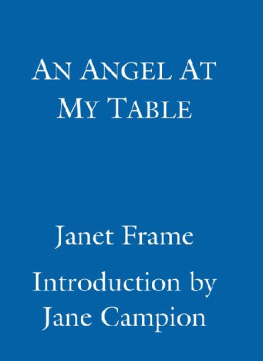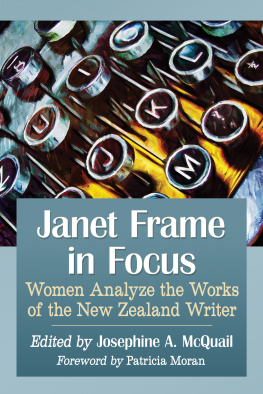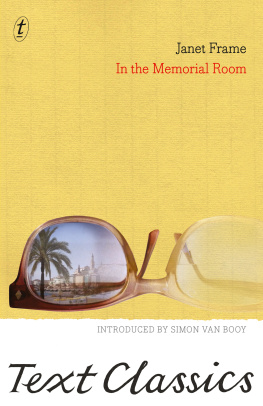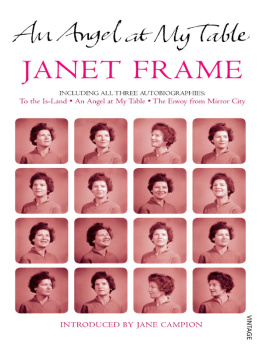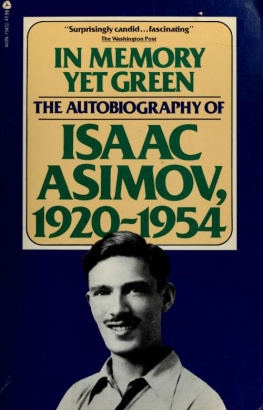
VIRAGO MODERN
CLASSICS
533

Janet Frame (19242004) was one of New Zealands most distinguished writers. She is best known for her autobiography, which inspired Jane Campions internationally acclaimed film, An Angel at My Table. Michael Holroyd hailed it as one of the greatest autobiographies written in the twentieth century. She was also the author of twelve novels, five collections of short stories, two volumes of poetry and a childrens book.
Throughout her long career Janet Frame received a wide range of awards. They included every literary prize for which she was eligible in New Zealand, honorary membership of the American Academy of Arts and Letters, and the Commonwealth prize for literature. She also won civil honours a CBE in 1983 for services to literature, the Order of New Zealand in 1990 and honorary doctorates and medals from three New Zealand universities.
The Lagoon and Other Stories
Owls Do Cry
Faces in the Water
The Edge of the Alphabet
Scented Gardens for the Blind
Snowman Snowman: Fables and Fantasies
The Reservoir: Stories and Sketches
The Adaptable Man
A State of Siege
The Reservoir and other stories
The Pocket Mirror
The Rainbirds
Mona Minim and the Smell of the Sun
Intensive Care
Daughter Buffalo
Living in the Maniototo
You Are Now Entering the Human Heart
The Carpathians
The Goose Bath
Towards Another Summer
Published by Virago
ISBN: 978-0-34900-669-7
All characters and events in this publication, other than those clearly in the public domain, are fictitious and any resemblance to real persons, living or dead, is purely coincidental.
Copyright Janet Frame 1982, 1984, 1985, 1989
The moral right of the author has been asserted.
Originally published in three separate volumes:
To the Is-Land first published in 1982
An Angel at My Table first published in 1984
The Envoy from Mirror City first published in 1985
Introduction copyright Jane Campion 2008
All rights reserved. No part of this publication may be reproduced, stored in a retrieval system, or transmitted, in any form or by any means, without the prior permission in writing of the publisher.
The publisher is not responsible for websites (or their content) that are not owned by the publisher.
Virago
Little, Brown Book Group
100 Victoria Embankment
London, EC4Y 0DY
www.littlebrown.co.uk
www.hachette.co.uk
Contents
Janet Frames first novel, Owls Do Cry, created a publishing sensation in New Zealand. It was hailed as the countrys long-awaited first great novel and a masterpiece by some, and criticised for being modern and too depressing by others who hated the italicised inner monologue, but for me when I read it at fourteen, the same age as Daphne in the novel, Daphne of the dead room, her dark, eloquent song captured my heart.
The day is early with birds beginning and the wren in a cloud piping like the child in the poem, drop thy pipe, thy happy pipe. And the place grows bean flower, pea-green lush of grass, swarm of insects dizzily hitting the high spots.
It was this inner world of gorgeously imagined riches that Janet affirmed in Daphne, but also in me, and quite probably in all sensitive teenage girls. We had been given a voice, poetic, powerful and fated a beautiful, mysterious song of the soul.
I read the book at fourteen when my life felt like torture. I remember sitting up in bed, leaning against my white plastic headboard, my filmy white chiffon bed cover stretching out in front of me, matching my rose-embroidered curtains. My room had none of the romantic mood I had dreamed about when I imagined the bed cover and the curtains hovering like a forest mist above my green carpet; instead they were a fire hazard with my bar heater, a humiliation evidence of my effort at romanticism and its failure. But where I had failed to create an atmosphere, Janet had succeeded magnificently and I loved it.
Owls Do Cry is experimental and partly based on events in Janets own life, including her experience of spending eight years intermittently in mental asylums. It provoked many rumours and dark imaginings about her actual life. Some believed she was still in an asylum, perhaps having had a leucotomy, a genius tragically doomed to mental illness. Others said she had gone overseas and was living anonymously.
Most weekends our family drove to our beach house in Plimmerton, passing the notorious loony bin, Porirua Hospital.
Was Janet Frame in Porirua? I would ask, peering at the flat prison-like buildings surrounded by misshapen macrocarpas.
No, not Porirua.
Where?
Sunnyside.
Sunnyside? They call a mental hospital Sunnyside? Is she still there?
I looked and wondered.
I viewed her life with admiration, pity and fear. To be abnormal in New Zealand society was a stigma; to be mental was an unrecoverable shame.
Fifteen years later I was to become sadly familiar with Porirua Hospital, Ward K2, as my mother tried repeatedly to find some relief from the overwhelming terror and bleakness of her late-life depression. I visited Janet Frames territory, stepping over Maxs false leg left lying in the corridor, and trying to fend off an elderly man who shuffled with alarming purpose up to my mother in the day room, put his hands on her armrests and asked, Edith what will it cost me to sleep in your bedroom?
She was unfazed: Michael, I told you before, Im not going to discuss money.
In 1963 Janet Frame returned to New Zealand, and partly because of the whispers and conjecture that continued to surround her life, she decided to write the truth. In doing so, she began her three-volume autobiography, collected here under the title An Angel at My Table, which I believe is one of the most beautifully toned and moving books I have ever read and the best book ever written by a New Zealander.
She has achieved that supremely difficult task of finding a voice so natural it feels as if it was not written but always was. She does not falter; Janet Frame is born and we grow up with her. Janet does so much more than clarify her personal history of misdiagnosis she tells us her whole life, which is unexpectedly enchanted and also tragic. Apart from the years she spent in and out of mental hospitals I had no idea that two of her sisters had died by drowning in unrelated incidents, nor was I aware of the life-saving role Frank Sargeson played in offering her a place to live and teaching her how to survive as a writer. A later delight in the third volume was her love affairs, one on the island of Ibiza, and another with a Spanish man with two-toned shoes.
Perhaps Janets unique genius, and what makes the book for me a masterpiece, is the depth and openness with which she reveals her vulnerability; her ability to write about her pain and humiliation as calmly and even-handedly as her successes. She disarmed me. I wasnt asked to admire Janet, yet I got to know her in intimate detail and loved her tenderly.
Back in 1982 my mother sent the first volume of this autobiography to me in Sydney where I was living and studying filmmaking at the Australian Film Television and Radio School. The book had just been published and was not available in Australia. So fourteen years after first opening
Next page
